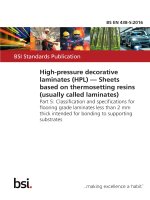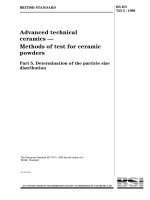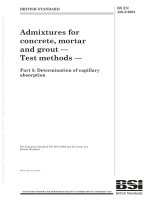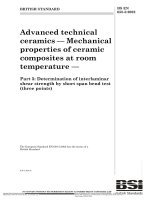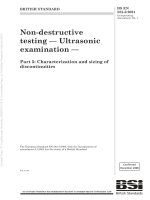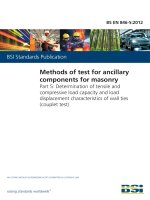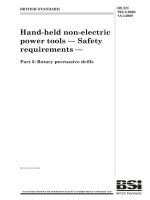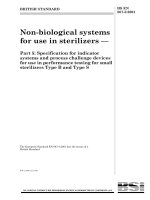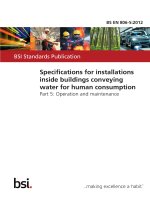Bsi bs en 61784 5 1 2013
Bạn đang xem bản rút gọn của tài liệu. Xem và tải ngay bản đầy đủ của tài liệu tại đây (1.31 MB, 42 trang )
BS EN 61784-5-1:2013
BSI Standards Publication
Industrial communication
networks — Profiles
Part 5-1: Installation of fieldbuses —
Installation profiles for CPF 1
BRITISH STANDARD
BS EN 61784-5-1:2013
National foreword
This British Standard is the UK implementation of EN 61784-5-1:2013. It is
identical to IEC 61784-5-1:2013.
The UK participation in its preparation was entrusted to Technical Committee AMT/7, Industrial communications: process measurement and
control, including fieldbus.
A list of organizations represented on this committee can be obtained on
request to its secretary.
This publication does not purport to include all the necessary provisions of
a contract. Users are responsible for its correct application.
© The British Standards Institution 2014.
Published by BSI Standards Limited 2014
ISBN 978 0 580 75929 1
ICS 25.040.40; 35.100.40
Compliance with a British Standard cannot confer immunity from
legal obligations.
This British Standard was published under the authority of the
Standards Policy and Strategy Committee on 31 January 2014.
Amendments/corrigenda issued since publication
Date
Text affected
BS EN 61784-5-1:2013
EN 61784-5-1
EUROPEAN STANDARD
NORME EUROPÉENNE
EUROPÄISCHE NORM
December 2013
ICS 25.040.40; 35.100.40
English version
Industrial communication networks Profiles Part 5-1: Installation of fieldbuses Installation profiles for CPF 1
(IEC 61784-5-1:2013)
Réseaux de communication industriels Profils Partie 5-1: Installation des bus de terrain Profils d'installation pour CPF 1
(CEI 61784-5-1:2013)
Industrielle Kommunikationsnetze Profile Teil 5-1: Feldbusinstallation Installationsprofile für die
Kommunikationsprofilfamilie 1
(IEC 61784-5-1:2013)
This European Standard was approved by CENELEC on 2013-10-16. CENELEC members are bound to comply
with the CEN/CENELEC Internal Regulations which stipulate the conditions for giving this European Standard
the status of a national standard without any alteration.
Up-to-date lists and bibliographical references concerning such national standards may be obtained on
application to the CEN-CENELEC Management Centre or to any CENELEC member.
This European Standard exists in three official versions (English, French, German). A version in any other
language made by translation under the responsibility of a CENELEC member into its own language and notified
to the CEN-CENELEC Management Centre has the same status as the official versions.
CENELEC members are the national electrotechnical committees of Austria, Belgium, Bulgaria, Croatia, Cyprus,
the Czech Republic, Denmark, Estonia, Finland, Former Yugoslav Republic of Macedonia, France, Germany,
Greece, Hungary, Iceland, Ireland, Italy, Latvia, Lithuania, Luxembourg, Malta, the Netherlands, Norway, Poland,
Portugal, Romania, Slovakia, Slovenia, Spain, Sweden, Switzerland, Turkey and the United Kingdom.
CENELEC
European Committee for Electrotechnical Standardization
Comité Européen de Normalisation Electrotechnique
Europäisches Komitee für Elektrotechnische Normung
CEN-CENELEC Management Centre: Avenue Marnix 17, B - 1000 Brussels
© 2013 CENELEC -
All rights of exploitation in any form and by any means reserved worldwide for CENELEC members.
Ref. No. EN 61784-5-1:2013 E
BS EN 61784-5-1:2013
EN 61784-5-1:2013
-2-
Foreword
The text of document 65C/738/FDIS, future edition 1 of IEC 61784-5-1, prepared by
SC 65C "Industrial networks" of IEC/TC 65 "Industrial-process measurement, control and automation"
was submitted to the IEC-CENELEC parallel vote and approved by CENELEC as EN 61784-5-1:2013.
The following dates are fixed:
•
latest date by which the document has to be
implemented at national level by
publication of an identical national
standard or by endorsement
(dop)
2014-07-16
•
latest date by which the national
standards conflicting with the
document have to be withdrawn
(dow)
2016-10-16
This standard is to be used in conjunction with EN 61918:2013.
Attention is drawn to the possibility that some of the elements of this document may be the subject of
patent rights. CENELEC [and/or CEN] shall not be held responsible for identifying any or all such
patent rights.
Endorsement notice
The text of the International Standard IEC 61784-5-1:2013 was approved by CENELEC as a
European Standard without any modification.
BS EN 61784-5-1:2013
EN 61784-5-1:2013
-3-
Annex ZA
(normative)
Normative references to international publications
with their corresponding European publications
The following documents, in whole or in part, are normatively referenced in this document and are
indispensable for its application. For dated references, only the edition cited applies. For undated
references, the latest edition of the referenced document (including any amendments) applies.
NOTE When an international publication has been modified by common modifications, indicated by (mod), the relevant EN/HD
applies.
Annex ZA of EN 61918:2013 applies, except as follows:
Publication
Year
Title
EN/HD
Year
EN 61918
2013
Addition to Annex ZA of EN 61918:2013:
IEC 61918
2013
Industrial communication networks Installation of communication networks in
industrial premises
–2–
BS EN 61784-5-1:2013
61784-5-1 © IEC:2013
CONTENTS
INTRODUCTION ..................................................................................................................... 9
1
Scope ............................................................................................................................. 10
2
Normative references ..................................................................................................... 10
3
Terms, definitions and abbreviated terms ....................................................................... 10
4
CPF 1: Overview of installation profiles .......................................................................... 10
5
Installation profile conventions ....................................................................................... 10
6
Conformance to installation profiles ................................................................................ 11
Annex A (Normative) CP 1/1 (F OUNDATION ™ H1) specific installation profile ........................ 13
A.1 Installation profile scope ................................................................................................. 13
A.2 Normative references ..................................................................................................... 13
A.3 Installation profile terms, definitions, and abbreviated terms ........................................... 13
A.3.1 Terms and definitions ............................................................................................ 13
A.3.2 Abbreviated terms ................................................................................................. 13
A.3.3 Conventions for installation profiles ....................................................................... 13
A.4 Installation planning ....................................................................................................... 13
A.4.1 General ................................................................................................................. 13
A.4.2 Planning requirements ........................................................................................... 13
A.4.2.1 Safety ........................................................................................................ 13
A.4.2.2 Security ..................................................................................................... 13
A.4.2.3 Environmental considerations and EMC ..................................................... 13
A.4.2.4 Specific requirements for generic cabling in accordance with
ISO/IEC 24702 .......................................................................................... 13
A.4.3 Network capabilities .............................................................................................. 14
A.4.3.1 Network topology ....................................................................................... 14
A.4.3.2 Network characteristics ............................................................................. 16
A.4.4 Selection and use of cabling components .............................................................. 18
A.4.4.1
Cable selection ..................................................................................... 18
A.4.4.2
Connecting hardware selection ............................................................. 19
A.4.4.3
Connections within a channel/permanent link ........................................ 20
A.4.4.4
Terminators .......................................................................................... 21
A.4.4.5
Device location and connection ............................................................. 21
A.4.4.6
Coding and labelling ............................................................................. 21
A.4.4.7
Earthing and bonding of equipment and devices and shielded
cabling .................................................................................................. 22
A.4.4.8
Storage and transportation of cables ..................................................... 23
A.4.4.9
Routing of cables .................................................................................. 24
A.4.4.10 Separation of circuit .............................................................................. 24
A.4.4.11 Mechanical protection of cabling components ....................................... 24
A.4.4.12 Installation in special areas ................................................................... 24
A.4.5 Cabling planning documentation ............................................................................ 24
A.4.5.1 Common description .................................................................................. 24
A.4.5.2 Cabling planning documentation for CPs ................................................... 24
A.4.5.3 Network certification documentation .......................................................... 24
BS EN 61784-5-1:2013
61784-5-1 © IEC:2013
–3–
A.4.5.4 Cabling planning documentation for generic cabling in accordance
with ISO/IEC 24702 ................................................................................... 24
A.4.6 Verification of cabling planning specification ......................................................... 24
A.5 Installation implementation ............................................................................................. 24
A.5.1 General requirements ............................................................................................ 24
A.5.2 Cable installation ................................................................................................... 24
A.5.2.1 General requirements for all cabling types ................................................. 24
A.5.2.2 Installation and routing .............................................................................. 25
A.5.2.3 Specific cable installation requirements for CPs ........................................ 25
A.5.2.4 Specific requirements for wireless installation ............................................ 25
A.5.2.5 Specific requirements for generic cabling in accordance with
ISO/IEC 24702 .......................................................................................... 25
A.5.3 Connector installation ............................................................................................ 25
A.5.3.1 Common description .................................................................................. 25
A.5.3.2 Shielded connectors .................................................................................. 25
A.5.3.3 Unshielded connectors .............................................................................. 25
A.5.3.4 Specific requirements for CPs ................................................................... 25
A.5.3.5 Specific requirements for generic cabling in accordance with ISO/IEC
24702 ........................................................................................................ 25
A.5.4 Terminator installation ........................................................................................... 25
A.5.5 Device installation ................................................................................................. 26
A.5.6 Coding and labelling .............................................................................................. 26
A.5.7 Earthing and bonding of equipment and devices and shield cabling ....................... 26
A.5.7.1 Common description .................................................................................. 26
A.5.7.2 Bonding and earthing of enclosures and pathways .................................... 26
A.5.7.3 Earthing methods ...................................................................................... 26
A.5.7.4 Shield earthing methods ............................................................................ 26
A.5.7.5 Specific requirements for CPs ................................................................... 26
A.5.7.6 Specific requirements for generic cabling in accordance with ISO/IEC
24702 ........................................................................................................ 26
A.5.8 As-implemented cabling documentation ................................................................. 26
A.6 Installation verification and installation acceptance test .................................................. 26
A.6.1 General ................................................................................................................. 26
A.6.2 Installation verification ........................................................................................... 26
A.6.3 Installation acceptance test ................................................................................... 26
A.6.3.1 General ..................................................................................................... 26
A.6.3.2 Acceptance test of Ethernet-based cabling ................................................ 26
A.6.3.3 Acceptance test of non-Ethernet-based cabling ......................................... 26
A.6.3.4 Specific requirements for wireless installation ............................................ 26
A.6.3.5 Acceptance test report ............................................................................... 27
A.7 Installation administration ............................................................................................... 27
A.7.1
A.7.2
A.7.3
A.7.4
A.7.5
A.7.6
A.7.7
A.7.8
General ................................................................................................................. 27
Fields covered by the administration ..................................................................... 27
Basic principles for the administration system ....................................................... 27
Working procedures .............................................................................................. 27
Device location labelling ........................................................................................ 27
Component cabling labelling .................................................................................. 27
Documentation ...................................................................................................... 27
Specific requirements for administration ................................................................ 27
–4–
BS EN 61784-5-1:2013
61784-5-1 © IEC:2013
A.8 Installation maintenance and installation troubleshooting ............................................... 27
A.8.1 General ................................................................................................................. 27
A.8.2 Maintenance .......................................................................................................... 27
A.8.3 Troubleshooting .................................................................................................... 27
A.8.4 Specific requirements for maintenance and troubleshooting .................................. 27
Annex B (normative) CP 1/2 (F OUNDATION ™ HSE) specific installation profile ...................... 28
B.1 Installation profile scope ................................................................................................. 28
B.2 Normative references ..................................................................................................... 28
B.3 Installation profile terms, definitions, and abbreviated terms ........................................... 28
B.3.1 Terms and definitions ............................................................................................ 28
B.3.2 Abbreviated terms ................................................................................................. 28
B.3.3 Conventions for installation profiles ....................................................................... 28
B.4 Installation planning ....................................................................................................... 28
B.4.1 General ................................................................................................................. 28
B.4.2 Planning requirements ........................................................................................... 28
B.4.3 Network capabilities .............................................................................................. 28
B.4.3.1 Network topology ....................................................................................... 28
B.4.3.2 Network characteristics ............................................................................. 28
B.4.4 Selection and use of cabling components .............................................................. 29
B.4.4.1
Cable selection ..................................................................................... 29
B.4.4.2
Connecting hardware selection ............................................................. 31
B.4.4.3
Connections within a channel/permanent link ........................................ 31
B.4.4.4
Terminators .......................................................................................... 31
B.4.4.5
Device location and connection ............................................................. 31
B.4.4.6
Coding and labelling ............................................................................. 32
B.4.4.7
Earthing and bonding of equipment and devices and shielded
cabling .................................................................................................. 32
B.4.4.8
Storage and transportation of cables ..................................................... 32
B.4.4.9
Routing of cables .................................................................................. 32
B.4.4.10 Separation of circuits ............................................................................ 32
B.4.4.11 Mechanical protection of cabling components ....................................... 32
B.4.4.12 Installation in special areas ................................................................... 32
B.4.5 Cabling planning documentation ............................................................................ 32
B.4.6 Verification of cabling planning specification ......................................................... 32
B.5 Installation implementation ............................................................................................. 33
B.5.1 General requirements ............................................................................................ 33
B.5.2 Cable installation ................................................................................................... 33
B.5.2.1 General requirements for all cabling types ................................................. 33
B.5.2.2 Installation and routing .............................................................................. 33
B.5.2.3 Specific cable installation requirements for CPs ........................................ 33
B.5.2.4 Specific requirements for wireless installation ............................................ 33
B.5.2.5 Specific requirements for generic cabling in accordance with
ISO/IEC 24702 .......................................................................................... 34
B.5.3 Connector installation ............................................................................................ 34
B.5.4 Terminator installation ........................................................................................... 34
B.5.5 Device installation ................................................................................................. 34
B.5.5.1 Common description .................................................................................. 34
B.5.5.2 Specific requirements for CPs ................................................................... 34
BS EN 61784-5-1:2013
61784-5-1 © IEC:2013
–5–
B.5.6 Coding and labelling .............................................................................................. 34
B.5.6.1 Common description .................................................................................. 34
B.5.6.2 Specific requirements for CPs ................................................................... 34
B.5.7 Earthing and bonding of equipment and devices and shield cabling ....................... 34
B.5.7.1 Common description .................................................................................. 34
B.5.7.2 Bonding and earthing of enclosures and pathways .................................... 34
B.5.7.3 Earthing methods ...................................................................................... 34
B.5.7.4 Shield earthing methods ............................................................................ 34
B.5.7.5 Specific requirements for CPs ................................................................... 34
B.5.7.6 Specific requirements for generic cabling in accordance with ISO/IEC
24702 ........................................................................................................ 34
B.5.8 As-implemented cabling documentation ................................................................. 34
B.6 Installation verification and installation acceptance test .................................................. 34
B.6.1 General ................................................................................................................. 34
B.6.2 Installation verification ........................................................................................... 34
B.6.2.1
General ................................................................................................. 34
B.6.2.2
Verification according to cabling planning documentation ...................... 34
B.6.2.3
Verification of earthing and bonding ...................................................... 34
B.6.2.4
Verification of shield earthing ................................................................ 35
B.6.2.5
Verification of cabling system ................................................................ 35
B.6.2.6
Cable selection verification ................................................................... 35
B.6.2.7
Connector verification ........................................................................... 35
B.6.2.8
Connection verification .......................................................................... 35
B.6.2.9
Terminators verification ......................................................................... 35
B.6.2.10 Coding and labelling verification ........................................................... 35
B.6.2.11 Verification report ................................................................................. 35
B.6.3 Installation acceptance test ................................................................................... 35
B.6.3.1 General ..................................................................................................... 35
B.6.3.2 Acceptance test of Ethernet-based cabling ................................................ 35
B.6.3.3 Acceptance test of non-Ethernet-based cabling ......................................... 35
B.6.3.4 Specific requirements for wireless installation ............................................ 36
B.6.3.5 Acceptance test report ............................................................................... 36
B.7 Installation administration ............................................................................................... 36
B.7.1 General ................................................................................................................. 36
B.7.2 Fields covered by the administration ..................................................................... 36
B.7.3 Basic principles for the administration system ....................................................... 36
B.7.4 Working procedures .............................................................................................. 36
B.7.5 Device location labelling ........................................................................................ 36
B.7.6 Component cabling labelling .................................................................................. 36
B.7.7 Documentation ...................................................................................................... 36
B.7.8 Specific requirements for administration ................................................................ 36
B.8 Installation maintenance and installation troubleshooting ............................................... 36
B.8.1 General ................................................................................................................. 36
B.8.2 Maintenance .......................................................................................................... 36
B.8.3 Troubleshooting .................................................................................................... 36
B.8.4 Specific requirements for maintenance and troubleshooting .................................. 36
Bibliography .......................................................................................................................... 37
Figure 1 – Standards relationships .......................................................................................... 9
–6–
BS EN 61784-5-1:2013
61784-5-1 © IEC:2013
Figure A.1 – Tree topology ................................................................................................... 14
Figure A.2 – Bus topology ..................................................................................................... 15
Figure A.3 – Combination of the tree topology and the bus topology ..................................... 15
Figure A.4 – Fieldbus extension ............................................................................................ 16
Table A.1 – Limit values for distortion, reflection and signal delay......................................... 17
Table A.2 – Recommended maximum cable lengths including spurs ..................................... 17
Table A.3 – Recommended length of the spurs ..................................................................... 17
Table A.4 – Maximum length of the splices ........................................................................... 18
Table A.5 – Information relevant to copper cable: fixed cables .............................................. 19
Table A.6 – Connectors for copper cabling CPs not based on Ethernet ................................. 20
Table A.7 – Parameters for balanced cables ......................................................................... 25
Table B.1 – Network characteristics for balanced cabling based on Ethernet ........................ 29
Table B.2 –Information relevant to copper cable: fixed cables ............................................... 30
Table B.3 – Information relevant to copper cable: cords ........................................................ 30
Table B.4 – Connectors for balanced cabling CPs based on Ethernet ................................... 31
Table B.5 – Parameters for balanced cables ......................................................................... 33
BS EN 61784-5-1:2013
61784-5-1 © IEC:2013
–9–
INTRODUCTION
This International Standard is one of a series produced to facilitate the use of communication
networks in industrial control systems.
IEC 61918:2013 provides the common requirements for the installation of communication
networks in industrial control systems. This installation profile standard provides the
installation profiles of the communication profiles (CP) of a specific communication profile
family (CPF) by stating which requirements of IEC 61918 fully apply and, where necessary, by
supplementing, modifying, or replacing the other requirements (see Figure 1).
For general background on fieldbuses, their profiles, and relationship between the installation
profiles specified in this standard, see IEC 61158-1.
Each CP installation profile is specified in a separate annex of this standard. Each annex is
structured exactly as the reference standard IEC 61918 for the benefit of the persons
representing the roles in the fieldbus installation process as defined in IEC 61918 (planner,
installer, verification personnel, validation personnel, maintenance personnel, administration
personnel). By reading the installation profile in conjunction with IEC 61918, these persons
immediately know which requirements are common for the installation of all CPs and which
are modified or replaced. The conventions used to draft this standard are defined in Clause 5.
The provision of the installation profiles in one standard for each CPF (for example
IEC 61784-5-1 for CPF 1), allows readers to work with standards of a convenient size.
Figure 1 – Standards relationships
– 10 –
BS EN 61784-5-1:2013
61784-5-1 © IEC:2013
INDUSTRIAL COMMUNICATION NETWORKS –
PROFILES –
Part 5-1: Installation of fieldbuses –
Installation profiles for CPF 1
1
Scope
This part of IEC 61784-5 specifies the installation profiles for CPF 1 (F OUNDATION ™
Fieldbus 1).
The installation profiles are specified in Annexes A and B. These annexes are read in
conjunction with IEC 61918:2013.
2
Normative references
The following documents, in whole or in part, are normatively referenced in this document and
are indispensable for its application. For dated references, only the edition cited applies. For
undated references, the latest edition of the referenced document (including any
amendments) applies.
IEC 61918:2013, Industrial communication networks – Installation of communication networks
in industrial premises
The normative references of IEC 61918:2013, Clause 2, apply. For profile specific normative
references, see Clause A.2
3
Terms, definitions and abbreviated terms
For the purposes of this document, the terms, definitions and abbreviated terms given in
IEC 61918:2013, Clause 3, apply.
4
CPF 1: Overview of installation profiles
CPF 1 consists of two communication profiles as specified in IEC 61784-1.
The installation requirements for CP 1/1 (F OUNDATION ™ H1) are specified in Annex A.
The installation requirements for CP 1/2 (F OUNDATION ™ HSE) are specified in Annex B.
5
Installation profile conventions
The numbering of the clauses and subclauses in the annexes of this standard corresponds to
the numbering of IEC 61918 main clauses and subclauses.
___________
1
FOUNDATION™ fieldbus is the trade name of the non-profit consortium Fieldbus Foundation. This information is given for the
convenience of users of this document and does not constitute an endorsement by IEC of the trademark holder or any of its
products. Compliance does not require use of the trade name. Use of the trade name requires permission of the trade name
holder.
BS EN 61784-5-1:2013
61784-5-1 © IEC:2013
– 11 –
The annex clauses and subclauses of this standard supplement, modify, or replace the
respective clauses and subclauses in IEC 61918.
Where there is no corresponding subclause of IEC 61918 in the normative annexes in this
standard, the subclause of IEC 61918 applies without modification.
The annex heading letter represents the installation profile assigned in Clause 4. The annex
heading number shall represent the corresponding numbering of IEC 61918.
EXAMPLE
“Subclause B.4.4” in IEC 61784-5-1 means that CP 1/2 specifies the subclause 4.4 of IEC 61918.
All main clauses of IEC 61918 are cited and apply in full unless otherwise stated in each
normative installation profile annex.
If all subclauses of a (sub)clause are omitted, then the corresponding IEC 61918 (sub)clause
applies.
If in a (sub)clause it is written
IEC 61918 (sub)clause does not apply.
“Not
applicable.”,
then
the
corresponding
If in a (sub)clause it is written “Addition:”, then the corresponding IEC 61918 (sub)clause
applies with the additions written in the profile.
If in a (sub)clause it is written “Replacement:”, then the text provided in the profile replaces
the text of the corresponding IEC 61918 (sub)clause.
NOTE
A replacement can also comprise additions.
If in a (sub)clause it is written “Modification:”, then the corresponding IEC 61918 (sub)clause
applies with the modifications written in the profile.
If all (sub)clauses of a (sub)clause are omitted but in this (sub)clause it is written
“(Sub)clause x has addition:” (or “replacement:”) or “(Sub)clause x is not applicable.”, then
(Sub)clause x becomes valid as declared and all the other corresponding
IEC 61918 (sub)clauses apply.
6
Conformance to installation profiles
Each installation profile within this standard includes part of IEC 61918:2013. It may also
include defined additional specifications.
A statement of compliance to an installation profile of this standard shall be stated 2 as either
Compliance to IEC 61784-5-1:2013 3 for CP 1/m <name> or
Compliance to IEC 61784-5-1 (Ed.1.0) for CP 1/m <name>
where the name within the angle brackets < > is optional and the angle brackets are not to be
included. The m within CP 1/m shall be replaced by the profile number 1 or 2.
NOTE
The name can be the name of the profile, for example F OUNDATION ™ H1.
If the name is a trade name then the permission of the trade name holder shall be required.
___________
2
In accordance with ISO/IEC Directives.
3
The date should not be used when the edition number is used.
– 12 –
BS EN 61784-5-1:2013
61784-5-1 © IEC:2013
Product standards shall not include any conformity assessment aspects (including quality
management provisions), neither normative nor informative, other than provisions for product
testing (evaluation and examination).
BS EN 61784-5-1:2013
61784-5-1 © IEC:2013
– 13 –
Annex A
(Normative)
CP 1/1 (F OUNDATION ™ H1) specific installation profile
A.1
Installation profile scope
Addition:
This standard specifies the installation profile for Communication
(F OUNDATION ™ H1). The CP 1/1 is specified in IEC 61784-1.
A.2
Profile
CP 1/1
Normative references
Addition:
IEC 60079-13:2010, Explosive atmospheres – Part 13: Equipment protection by pressurized
room "p"
A.3
Installation profile terms, definitions, and abbreviated terms
A.3.1
Terms and definitions
A.3.2
Abbreviated terms
A.3.3
Conventions for installation profiles
Not applicable.
A.4
Installation planning
A.4.1
General
A.4.2
Planning requirements
A.4.2.1
Safety
A.4.2.1.1
General
A.4.2.1.2
Electrical safety
A.4.2.1.3
Functional safety
A.4.2.1.4
Intrinsic safety
A.4.2.1.5
Safety of optical fibre communication systems
Not applicable.
A.4.2.2
Security
A.4.2.3
Environmental considerations and EMC
A.4.2.4
Specific requirements for generic cabling in accordance with ISO/IEC 24702
BS EN 61784-5-1:2013
61784-5-1 © IEC:2013
– 14 –
Not applicable.
A.4.3
Network capabilities
A.4.3.1
Network topology
A.4.3.1.1
Common description
A.4.3.1.2
Basic physical topologies for passive networks
Addition:
The tree topology (see Figure A.1) can be compared to classic field installation topology. The
multi-wire trunk cable is replaced by the two-wire fieldbus trunk cable. The junction box
retains its role as a central connection unit where all field devices are connected in parallel.
The location of the power supply can be in the control room or field in any topology.
Control room
AS
Field
SiC
JB
PS
Key
AS
SiC
PS
T
JB
(1)...(n)
Automation system
Signal coupler
Power suppy
Line terminator
Junction box
Field devices
Figure A.1 – Tree topology
The bus topology (see Figure A.2) offers connection points (taps or passive couplers) along
the fieldbus cable. The cable can be looped through the individual field devices. Field devices
may also be connected to the trunk cable via spurs. The combination of tree topology and bus
topology (see Figure A.3) permits the optimization of the fieldbus length and the adaptation to
existing system structures. The restricting factor for fieldbus design is the attenuation of the
communication signal between the fieldbus stations and the signal distortions caused by the
concentration of fieldbus stations along the fieldbus cable. The location of the power supply
can be in the control room or field. For more details, see IEC 61158-2.
BS EN 61784-5-1:2013
61784-5-1 © IEC:2013
– 15 –
Field
Control room
SiC
AS
PS
Key
AS
SiC
PS
T
(1)...(n)
Automation system
Signal coupler
Power suppy
Line terminator
Field devices
Figure A.2 – Bus topology
Tree topology, bus topology or a combination of both can be used as the fieldbus structure for
the CP 1/1 shown in Figure A.3.
Control room
AS
Field
SiC
PS
Key
AS
SiC
PS
T
JB
(1)...(n)
Automation system
Signal coupler
Power suppy
Line terminator
Junction box
Field devices
Figure A.3 – Combination of the tree topology and the bus topology
The topology can be extended through the use of repeaters for CP 1/1 as shown in Figure A.4.
BS EN 61784-5-1:2013
61784-5-1 © IEC:2013
– 16 –
Field
Control room
SiC
AS
R
PS
Key
AS
SiC
PS
T
JB
R
(1)...(n)
Automation system
Signal coupler
Power suppy
Line terminator
Junction box
Repeater
Field devices
Figure A.4 – Fieldbus extension
The number of field devices that can be used on the fieldbus depends on the supply voltage,
the current consumption of the field devices and the extension of the fieldbus.
A.4.3.1.3
Basic physical topologies for active networks
Not applicable.
A.4.3.1.4
Combination of basic topologies
See A.4.3.1.2.
A.4.3.1.5
Specific requirements for CPs
Not applicable.
A.4.3.1.6
A.4.3.2
Specific requirements for generic cabling in accordance with
ISO/IEC 24702
Network characteristics
A.4.3.2.1
General
A.4.3.2.2
Network characteristics for balanced cabling not based on Ethernet
Replacement:
Every fieldbus installation shall comply with certain rules (that means the network
configuration rules). The rules in 12.3.3 of IEC 61158-2:2010 specify the limit values for
attenuation, reflection and distortions in rule 8 and the maximum signal delay in rule 4 that are
permitted in the network. Table A.1 summarizes these values.
BS EN 61784-5-1:2013
61784-5-1 © IEC:2013
– 17 –
Table A.1 – Limit values for distortion, reflection and signal delay
Attribute
Value
Attenuation between any two fieldbus interfaces (at 31,25 kHz)
10,5 dB
Attenuation distortion a(f = 39 kHz) - a(f = 7,8 kHz) , ascending monotonically with f
6 dB
Mismatching distortion at any point (7,8 kHz to 39 kHz)
0,2
Maximum propagation delay between any two devices
640 µs
In a non-hazardous area all topologies of A.4.3.1.2 and all cables are permitted within the
framework of these limit values.
Since individual calculation of the above four parameters for all possible connections between
two fieldbus interfaces to obtain the optimal layout is very time-consuming, rules have been
specified for a basic topology which, although below the optimum, will ensure that the above
limit values will not be exceeded.
A tree topology was selected as the basic model of a network. This network consists of a
main cable (that means trunk), a number of stub cables (that means spurs), connection
elements (that means splices), and two line terminators. The total cable length is the sum of
the lengths of the main cable and all spurs.
IEC 61158-2 requires not exceeding the values listed in Table A.2, Table A.3, and Table A.4.
Although different cable types can be mixed in one network segment, this should be avoided.
Determining the maximum cable lengths for such mixed structures is more time-consuming
and less accurate than using structures consisting of only one type of cable.
Table A.2 – Recommended maximum cable lengths including spurs
Type of cable
Total cable length
A
1 900
B
1 200
C
400
D
200
m
Table A.3 – Recommended length of the spurs
Length of one stub cable
(Intrinsically safe)
Length of one stub cable
(Not intrinsically safe)
m
m
25 to 32
—
—
19 to 24
30
Number of stub cables
15 to 18
30
13 to 14
30
a
90
1 to 12
30
a
120
Spurs ≤ 1 m shall be considered as splices.
a
30
a
Preliminary values in accordance with FISCO.
60
BS EN 61784-5-1:2013
61784-5-1 © IEC:2013
– 18 –
Table A.4 – Maximum length of the splices
Total cable length
Total length of the splices
m
≥ 400
8m
< 400
2%
The network can be enlarged with repeaters. The above limit values then apply to each
individual network segment, and only the maximum signal delay shall be calculated for the
total network.
A.4.3.2.3
Network characteristics for balanced cabling based on Ethernet
Not applicable.
A.4.3.2.4
Network characteristics for optical fibre cabling
Not applicable
A.4.3.2.5
Specific network characteristics
Not applicable.
A.4.3.2.6
A.4.4
Specific requirements for generic cabling in accordance with
ISO/IEC 24702
Selection and use of cabling components
A.4.4.1
Cable selection
A.4.4.1.1
Common description
Addition:
Generic cabling in accordance with ISO/IEC 24702 is not suitable for the cabling of CP 1/1
networks.
CP 1/1 networks only can be connected to the generic cabling via converter/adapter as
specified in IEC 61918:2013, 4.1.2.
A.4.4.1.2
Copper cables
A.4.4.1.2.1
Balanced cables for Ethernet-based CPs
Not applicable
A.4.4.1.2.2
Copper cables for non-Ethernet-based CPs
Replacement:
CP 1/1 according to IEC 61784-1 requires that a two-wire cable shall be used as the
transmission medium for the fieldbus. Although the electrical data is not specified, this data
influences the performance that can be achieved by the fieldbus (that means distances which
can be covered, number of stations, electromagnetic compatibility). Subclause 13.8.2 in
IEC 61158-2:2010 is required for fieldbus tests and IEC 61158-2:2010, Annex B (informative)
is recommended. Table A.5 distinguishes between four types of cables for a temperature of
25 °C.
BS EN 61784-5-1:2013
61784-5-1 © IEC:2013
– 19 –
Table A.5 – Information relevant to copper cable: fixed cables
Characteristic
Type A
Type B
Type C
Type D
(Reference)
Cable description
Twisted pair,
shielded
One or more
twisted pairs,
total shielding
Several twisted
pairs, not
shielded
Several nontwisted pairs,
not shielded
Nominal conductor cross sectional area
0,8 mm 2
0,32 mm 2
0,13 mm 2
1,25 mm 2
(AWG 18)
(AWG 22)
(AWG 26)
(AWG 16)
Maximum d.c. resistance (loop)
44 Ω/km
112 Ω/km
264 Ω/km
40 Ω/km
Characteristic impedance at 31,25 kHz
100 Ω ±20 %
100 Ω ±30 %
a
a
Maximum attenuation at 39 kHz
3 dB/km
5 dB/km
8 dB/km
8 dB/km
Maximum capacitive unbalance
2 nF/km
2 nF/km
a
a
Group delay distortion (7,9 to 39 kHz)
1,7 µs/km
a
a
a
Surface covered by shield
90 %
a
–
–
Extent of network including spur cables
1 900 m
1 200 m
400 m
200 m
b
For maximum d.c. resistance (loop), the cross sectional area shall be the minimum value. All cable shall be annealed
copper, tin coated.
a
Not specified.
b
Using currently available insulation material allows the cable to meet the requirements.
The reference cable (that means type A) shall be used for the conformance tests.
When new systems are installed, cables that meet the minimum requirements of types A and
B shall be used. When multi-pair cables (that means type B) are used, several fieldbuses
(31,25 kbit/s) can be operated in one cable.
Installation of other electric circuits in the same cable should be avoided. Type C and D
cables should only be used for so called retrofit applications (that means use of already
installed cables) for substantially reduced networks. In such cases the interference
susceptibility of the transmission frequently does not meet the requirements.
A.4.4.1.3
Cables for wireless installation
A.4.4.1.4
Optical fibre cables
Not applicable.
A.4.4.1.5
Special purpose balanced and optical fibre cables
Not applicable.
A.4.4.1.6
Specific requirements for CPs
Not applicable.
A.4.4.1.7
A.4.4.2
Specific requirements for generic cabling in accordance with
ISO/IEC 24702
Connecting hardware selection
BS EN 61784-5-1:2013
61784-5-1 © IEC:2013
– 20 –
A.4.4.2.1
Common description
A.4.4.2.2
Connecting hardware for balanced cabling CPs based on Ethernet
Not applicable.
A.4.4.2.3
Connecting hardware for copper cabling CPs not based on Ethernet
Replacement:
Table A.6 provides values based on the template given in IEC 61918:2013, Table 8.
Table A.6 – Connectors for copper cabling CPs not based on Ethernet
IEC
60807-2
or
IEC
61169-8
IEC 61076-2-101
IEC
60807-3
ANSI/(NFPA)
T3.5.29 R1-2007
Others
Sub-D
M12-5 with
A-coding
M12-5 with
B-coding
M12-n with
X-coding
Coaxial
(BNC)
M 18
7/8-16
UN-2B
THD
Open
style
Terminal
block
Others
9 pin
Yes
No
No
No
No
Yes
No
No
No
CP
1/1
NOTE For M12-5 connectors, there are many applications using these connectors that are not compatible and
when mixed can cause damage to the applications.
A.4.4.2.4
Connecting hardware for wireless installation
A.4.4.2.5
Connecting hardware for optical fibre cabling
Not applicable.
A.4.4.2.6
Specific requirements for CPs
Not applicable.
A.4.4.2.7
A.4.4.3
Specific requirements for generic cabling in accordance with
ISO/IEC 24702
Connections within a channel/permanent link
A.4.4.3.1
Common description
A.4.4.3.2
Balanced cabling connections and splices for CPs based on Ethernet
Not applicable.
A.4.4.3.3
A.4.4.3.3.1
Copper cabling connections and splices for CPs not based on Ethernet
Common description
Addition:
Refer to the manufacturer's data sheet regarding the number of allowed connections.
A.4.4.3.3.2
Connections minimum distance
A.4.4.3.3.3
Copper cabling splices
A.4.4.3.3.4
Copper cabling bulkhead connections
BS EN 61784-5-1:2013
61784-5-1 © IEC:2013
A.4.4.3.3.5
A.4.4.3.4
– 21 –
Copper cabling J-J adaptors
Optical fibre cabling connections and splices for CPs based on Ethernet
Not applicable.
A.4.4.3.5
Optical fibre cabling connections and splices for CPs not based on
Ethernet
Not applicable.
A.4.4.3.6
A.4.4.4
Specific requirements for generic cabling in accordance with
ISO/IEC 24702
Terminators
A.4.4.4.1
Common description
A.4.4.4.2
Specific requirements for CPs
Addition:
For CP 1/1 networks terminators shall be used.
Line termination shall consist of a series circuit of one capacitor and one resistor on both
ends of the main fieldbus line.
Allowed values:
R = 100 Ω ± 2 %
C = 1 µF ± 20 %
A.4.4.4.3
A.4.4.5
Specific requirements for generic cabling in accordance with
ISO/IEC 24702
Device location and connection
A.4.4.5.1
Common description
A.4.4.5.2
Specific requirements for CPs
Not applicable.
A.4.4.5.3
Specific requirements for wireless installation
Not applicable.
A.4.4.5.4
A.4.4.6
Specific requirements for generic cabling in accordance with
ISO/IEC 24702
Coding and labelling
A.4.4.6.1
Common description
A.4.4.6.2
Additional requirements for CPs
A.4.4.6.3
Specific requirements for CPs
Not applicable.
– 22 –
A.4.4.6.4
A.4.4.7
A.4.4.7.1
BS EN 61784-5-1:2013
61784-5-1 © IEC:2013
Specific requirements for generic cabling in accordance with
ISO/IEC 24702
Earthing and bonding of equipment and devices and shielded cabling
Common description
A.4.4.7.1.1
Basic requirements
A.4.4.7.1.2
Planner tasks
A.4.4.7.1.3
Methods for controlling potential differences in the earth system
A.4.4.7.1.4
Selection of the earthing and bonding systems
A.4.4.7.2
Bonding and earthing of enclosures and pathways
A.4.4.7.2.1
Equalisation and earthing conductor sizing and length
A.4.4.7.2.2
Bonding straps and sizing
A.4.4.7.2.3
Surface preparation and methods
A.4.4.7.2.4
Bonding and earthing
A.4.4.7.3
Earthing methods
A.4.4.7.3.1
Equipotential
A.4.4.7.3.2
Star
A.4.4.7.3.3
Earthing of equipment (devices)
A.4.4.7.3.4
Copper bus bars
A.4.4.7.4
Shield earthing
A.4.4.7.4.1
Non-earthing or parallel RC
A.4.4.7.4.2
Direct
A.4.4.7.4.3
Derivatives of direct and parallel RC
A.4.4.7.5
Specific requirements for CPs
Addition:
For CP 1/1 four options are available to the planner for shield termination.
Single-point shield earthing (Class A) requires that the shield be connected to earth at only
one location on a network as provided in 4.1.2 of IEC 61918:2013. IEC 61158-2 recommends
single-point shielding installation. The cable shield is usually connected to the common
system referencing earth through the fieldbus power supply.
The advantage of this type of installation lies in its protection against interference frequencies
up to a few megahertz. Ripple frequencies in the 50 Hz or 60 Hz range and multiples thereof
(harmonic) are particularly well suppressed. These frequencies can come from power cables
routed parallel to the fieldbus cable.
Single-point shield earthing also offers protection against lightning. By separating the cable
shield and plant earthing, equalizing currents cannot flow over the cable shield. Thus, if
lightning strikes the plant, it cannot run through to the control system and cause damage.
BS EN 61784-5-1:2013
61784-5-1 © IEC:2013
– 23 –
Further EMC protection involves laying the fieldbus cable in a steel pipe (conduit) or armored
cable.
Multi-point shield earthing (Class B), or direct shield earthing as provided in 5.7.4.3, provides
the greatest degree of protection against electromagnetic interference, similar to conduit or
armored cable, in the upper frequency range even for interferences that are above several
megahertz. All the instrument and cable shields of the bus cable are connected to earth
locally which, in turn, has to be connected to earth in the safe area for installations in
hazardous areas. Multi-point shield earthing provides optimal protection from a single noise
source at any location.
In accordance with IEC 60079-13:2010, 12.2.2.3, this method can be used if the installation is
performed in such a way that provides a high degree of safety with regard to potential
matching. Under these conditions, this version meets the requirements of hazardous area
installation rules.
The disadvantage of multi-point shield earthing is seen in the event of poor equipotential
bonding system. If good potential matching is not possible between the earthing points of the
shield, the shield will become a current carrying conductor and induce noise into the network.
Multi-point shield earthing provides direct connection for lightning surges back to the control
room through the signal and shield wires and may require special attention.
Combined Topologies (Class C) uses a mixture of topologies from Class A (single-point) and
Class B (multi-point) with signal isolation located in the field junction box. The mixed topology
breaks up paths for ground circulation currents and surges that may exist in the Class B
topology. In this concept, the shield of the trunk segment from the control room to the field
junction boxes is connected to earth at a single location, typically at the fieldbus power supply.
At the junction box, the trunk shield should be continuous if multiple isolated device couplers
are used, but the trunk shield should not be connected to earth at the junction box.
On the field side, the shield is connected both at the instrument and at the isolated device
coupler. This topology is common in hazardous areas that involve a mixture of increased
safety and intrinsic safety and moves the barrier into the junction box to provide a maximum
number of devices for the segment. The trunk side maintains all of the benefits associated
with Class A while the field side provides enhanced electromagnetic noise immunity offered
by Class B.
Multi-point shielding using capacitive coupling (Class D) is a variation of multi-point shielding
(Class B) except that an adequate equipotential bonding system does not exist throughout the
plant site. Similar to Class B, this topology requires the shield to be connected to earth at
several points, including the instruments and field junction boxes. However, at the control
center area, the shield is connected to earth through a coupling capacitor. The coupling
capacitor is used to block DC ground loop currents that would result from a poor equipotential
bonding system.
Similar to Class B, this topology offers better EMC susceptibility at high frequencies and
blocks low frequency currents that would be carried by the shield in a multi-point shielding.
However, a fault condition, such as a lightning strike, could result in a high voltage being
present at the host system side. Class A, B or C is preferred topology over Class D.
A.4.4.7.6
A.4.4.8
Specific requirements for generic cabling in accordance with
ISO/IEC 24702
Storage and transportation of cables
